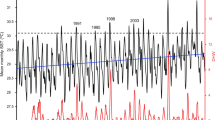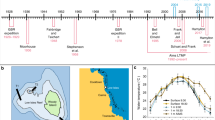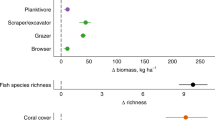Abstract
Threats from climate change and other human pressures have led to widespread concern for the future of Australia’s Great Barrier Reef (GBR). Resilience of GBR reefs will be determined by their ability to resist disturbances and to recover from coral loss, generating intense interest in management actions that can moderate these processes. Here we quantify the effect of environmental and human drivers on the resilience of southern and central GBR reefs over the past two decades. Using a composite water quality index, we find that while reefs exposed to poor water quality are more resistant to coral bleaching, they recover from disturbance more slowly and are more susceptible to outbreaks of crown-of-thorns starfish and coral disease—with a net negative impact on recovery and long-term hard coral cover. Given these conditions, we find that 6–17% improvement in water quality will be necessary to bring recovery rates in line with projected increases in coral bleaching among contemporary inshore and mid-shelf reefs. However, such reductions are unlikely to buffer projected bleaching effects among outer-shelf GBR reefs dominated by fast-growing, thermally sensitive corals, demonstrating practical limits to local management of the GBR against the effects of global warming.
This is a preview of subscription content, access via your institution
Access options
Access Nature and 54 other Nature Portfolio journals
Get Nature+, our best-value online-access subscription
$29.99 / 30 days
cancel any time
Subscribe to this journal
Receive 12 digital issues and online access to articles
$119.00 per year
only $9.92 per issue
Buy this article
- Purchase on Springer Link
- Instant access to full article PDF
Prices may be subject to local taxes which are calculated during checkout



Similar content being viewed by others
Data availability
All code and data to reproduce the entire analysis are available on GitHub: https://github.com/mamacneil/GBR_Gompertz.
References
Hughes, T. P. et al. Global warming and recurrent mass bleaching of corals. Nature 543, 373–377 (2017).
De’ath, G., Fabricius, K. E., Sweatman, H. & Puotinen, M. The 27-year decline of coral cover on the Great Barrier Reef and its causes. Proc. Natl Acad. Sci. USA 109, 17995–17999 (2012).
Cheal, A. J., MacNeil, M. A., Emslie, M. J. & Sweatman, H. The threat to coral reefs from more intense cyclones under climate change. Glob. Change Biol. 23, 1511–1524 (2017).
Maynard, J. et al. Projections of climate conditions that increase coral disease susceptibility and pathogen abundance and virulence. Nat. Clim. Change 5, 688–694 (2015).
Frieler, K. et al. Limiting global warming to 2 C is unlikely to save most coral reefs. Nat. Clim. Change 3, 165–170 (2013).
Logan, C. A., Dunne, J. P., Eakin, C. M. & Donner, S. D. Incorporating adaptive responses into future projections of coral bleaching. Glob. Change Biol. 20, 125–139 (2014).
Ainsworth, T. D. et al. Climate change disables coral bleaching protection on the Great Barrier Reef. Science 352, 338–342 (2016).
Hughes, T. P. et al. Spatial and temporal patterns of mass bleaching of corals in the Anthropocene. Science 359, 80–83 (2018).
Gilmour, J. P., Smith, L. D., Heyward, A. J., Baird, A. H. & Pratchett, M. S. Recovery of an isolated coral reef system following severe disturbance. Science 340, 69–71 (2013).
Bellwood, D. R., Hughes, T. P. & Hoey, A. S. Sleeping functional group drives coral-reef recovery. Curr. Biol. 16, 2434–2439 (2006).
Done, T. J. Phase shifts in coral reef communities and their ecological significance. Hydrobiologia 247, 121–132 (1992).
Johns, K. A., Osborne, K. O. & Logan, M. Contrasting rates of coral recovery and reassembly in coral communities on the Great Barrier Reef. Coral Reefs 33, 553–563 (2014).
Fabricius, K., De’ath, G., McCook, L., Turak, E. & Williams, D. M. Changes in algal, coral and fish assemblages along water quality gradients on the inshore Great Barrier Reef. Mar. Pollut. Bull. 51, 384–398 (2005).
Uthicke, S., Thompson, A. & Schaffelke, B. Effectiveness of benthic foraminiferal and coral assemblages as water quality indicators on inshore reefs of the Great Barrier Reef, Australia. Coral Reefs 29, 209–225 (2010).
Thompson, A., Schroeder, T., Brando, V. E. & Schaffelke, B. Coral community responses to declining water quality: Whitsunday Islands, Great Barrier Reef, Australia. Coral Reefs 33, 923–938 (2014).
Ortiz, J.-C. et al. Impaired recovery of the great barrier reef under cumulative stress. Sci. Adv. 4, eaar6127 (2018).
Ateweberhan, M., McClanahan, T. R., Graham, N. A. J. & Sheppard, C. R. C. Episodic heterogeneous decline and recovery of coral cover in the Indian Ocean. Coral Reefs 30, 739–752 (2011).
Hughes, T. P. et al. Coral reefs in the Anthropocene. Nature 546, 82–90 (2017).
Hughes, T. P., Day, J. C. & Brodie, J. Securing the future of the Great Barrier Reef. Nat. Clim. Change 5, 508–511 (2015).
Smith, J., Smith, C. & Hunter, C. An experimental analysis of the effects of herbivory and nutrient enrichment on benthic community dynamics on a Hawaiian reef. Coral Reefs 19, 332–342 (2001).
Fabricius, K. E., Okaji, K. & De’ath, G. Three lines of evidence to link outbreaks of the crown-of-thorns seastar Acanthaster planci to the release of larval food limitation. Coral Reefs 29, 593–605 (2010).
Willis, B. L., Page, C. A. & Dinsdale, E. A. Coral disease on the great barrier reef. in Coral Health and Disease (eds Rosenberg, E. & Loya, Y.) 69–104 (Springer, Berlin, 2004).
Ferrier-Pagès, C., Gattuso, J.-P., Dallot, S. & Jaubert, J. Effect of nutrient enrichment on growth and photosynthesis of the zooxanthellate coral Stylophora pistillata. Coral Reefs 19, 103–113 (2000).
Houk, P., Musburger, C. & Wiles, P. Water quality and herbivory interactively drive coral-reef recovery patterns in American Samoa. PLoS ONE 5, e13913 (2010).
Brodie, J. E. et al. Setting ecologically relevant targets for river pollutant loads to meet marine water quality requirements for the Great Barrier Reef, Australia: a preliminary methodology and analysis. Ocean Coast. Manag. 143, 136–147 (2017).
Fukaya, K., Okuda, T., Nakaoka, M., Hori, M. & Noda, T. Seasonality in the strength and spatial scale of processes determining intertidal barnacle population growth. J. Anim. Ecol. 79, 1270–1279 (2010).
Nyström, M., Graham, N. A. J., Lokrantz, J. & Norström, A. V. Capturing the cornerstones of coral reef resilience: linking theory to practice. Coral Reefs 27, 795–809 (2008).
Sweatman, H., Delean, S. & Syms, C. Assessing loss of coral cover on Australia’s Great Barrier Reef over two decades, with implications for longer-term trends. Coral Reefs 30, 521–531 (2011).
Pratchett, M. S., Caballes, C. F., Rivera-Posada, J. A. & Sweatman, H. P. A. Limits to understanding and managing outbreaks of crown-of-thorns starfish (Acanthaster spp.). Oceanogr. Mar. Biol. Annu. Rev. 52, 133–200 (2014).
Emslie, M. J., Cheal, A. J., Sweatman, H. P. A. & Delean, S. Recovery form disturbance of coral reef fish communities on the Great Barrier Reef, Australia. Mar. Ecol. Ser. 371, 177–190 (2008).
Emslie, M. J., Pratchett, M. S., Cheal, A. J. & Osborne, K. Great Barrier Reef butterflyfish community structure: the role of shelf position and benthic community type. Coral Reefs 29, 705–715 (2010).
Great Barrier Reef Marine Park Zoning Plan 2003 1–211 (Great Barrier Reef Marine Park Authority, 2004).
Petus, C., da Silva, E. T., Devlin, M., Wenger, A. S. & Álvarez-Romero, J. G. Using MODIS data for mapping of water types within river plumes inthe Great Barrier Reef, Australia: towards the production of river plume risk maps for reef and seagrass ecosystems. J. Environ. Manage. 137, 163–177 (2014).
Brodie, J., Devlin, M. & Lewis, S. Potential enhanced survivorship of crown of thorns starfish larvae due to near-annual nutrient enrichment during secondary outbreaks on the central mid-shelf of the Great Barrier Reef, Australia. Diversity 9, 17 (2017).
Vega Thurber, R. L. et al. Chronic nutrient enrichment increases prevalence and severity of coral disease and bleaching. Glob. Change Biol. 20, 544–554 (2014).
van Woesik, R., Cacciapaglia, C. & Randall, C. J. Thermal-stress response of coral communities to climate change. in The Cnidaria, Past, Present and Future: The World of Medusa and Her Sisters (eds Goffredo, S. & Dubinsky, Z.) 545–552 (Springer, Berlin, 2016).
Clark, T. R. et al. U-Th dating reveals regional-scale decline of branching Acropora corals on the Great Barrier Reef over the past century. Proc. Natl Acad. Sci. USA 114, 10350–10355 (2017).
Mongin, M. et al. The exposure of the Great Barrier Reef to ocean acidification. Nat. Commun. 7, 10732 (2016).
Safaie, A. et al. High frequency temperature variability reduces the risk of coral bleaching. Nat. Commun. 9, 1671 (2018).
Wiedenmann, J. et al. Nutrient enrichment can increase the susceptibility of reef corals to bleaching. Nat. Clim. Change 3, 160–164 (2013).
Wooldridge, S. A. & Brodie, J. E. Environmental triggers for primary outbreaks of crown-of-thorns starfish on the Great Barrier Reef, Australia. Mar. Pollut. Bull. 101, 805–815 (2015).
Hughes, T. P. et al. Global warming transforms coral reef assemblages. Nature 556, 492 (2018).
Connell, J. H., Hughes, T. P. & Wallace, C. C. A 30-year study of coral abundance, recruitment, and disturbance at several scales in space and time. Ecol. Monogr. 67, 461–488 (1997).
Kayanne, H., Harii, S., Ide, Y. & Akimoto, F. Recovery of coral populations after the 1998 bleaching on Shiraho Reef, in the southern Ryukyus, NW Pacific. Mar. Ecol. Prog. Ser. 239, 93–103 (2002).
MacNeil, M. A. et al. Recovery potential of the world’s coral reef fishes. Nature 520, 341–344 (2015).
Brodie, J. et al. Development of Basin-Specific Ecologically Relevant Water Quality Targets for the Great Barrier Reef (TropWATER, 2017). https://doi.org/10.13140/RG.2.2.36754.35526.
Anthony, K. R. N. & Fabricius, K. E. Shifting roles of heterotrophy and autotrophy in coral energetics under varying turbidity. J. Exp. Mar. Bio. Ecol. 252, 221–253 (2000).
Petus, C. et al. Estimating the exposure of coral reefs and seagrass meadows to land-sourced contaminants in river flood plumes of the great barrier reef: Validating a simple satellite risk framework with environmental data. Remote Sens. 8, 1–30 (2016).
Fabricius, K. E., Logan, M. M., Weeks, S. J., Lewis, S. E. & Brodie, J. Changes in water clarity in response to river discharges on the Great Barrier Reef continental shelf: 2002–2013. Esturar. Coast. Shelf Sci. 173, A1–A15 (2016).
Bessell-Browne, P. et al. Impacts of turbidity on corals: the relative importance of light limitation and suspended sediments. Mar. Pollut. Bull. 117, 161–170 (2017).
Birrell, C. L., McCook, L. J. & Willis, B. L. Effects of algal turfs and sediment on coral settlement. Mar. Pollut. Bul. 51, 408–414 (2005).
IPCC Climate Change 2014: Mitigation of Climate Change (eds Edenhofer, O. et al.) (Cambridge Univ. Press, Cambridge, 2014).
Van Hooidonk, R. et al. Local-scale projections of coral reef futures and implications of the Paris Agreement. Sci. Rep. 6, 39666 (2016).
Draft Reef 2050 Water Quality Improvement Plan 2017–2022 for Public Consultation (The State of Queensland, 2017).
Waterhouse, J. et al. Scientific Consensus Statement 2017: A Synthesis of the Science of Land-based Water Quality Impacts on the Great Barrier Reef (State of Queensland, 2017).
van Oppen, M. J. H. et al. Shifting paradigms in restoration of the world’s coral reefs. Glob. Change Biol. 23, 3437–3448 (2017).
Mellin, C., Aaron MacNeil, M., Cheal, A. J., Emslie, M. J. & Julian Caley, M. Marine protected areas increase resilience among coral reef communities. Ecol. Lett. 19, 629–637 (2016).
Norström, A. V. et al. Guiding coral reef futures in the Anthropocene. Front. Ecol. Environ. 14, 490–498 (2016).
Hoegh-Guldberg, O., Poloczanska, E. S., Skirving, W. & Dove, S. Coral reef ecosystems under climate change and ocean acidification. Front. Mar. Sci. 4, 158 (2017).
Wolff, N. H., Mumby, P. J., Devlin, M. & Anthony, K. R. N. Vulnerability of the Great Barrier Reef to climate change and local pressures. Glob. Change Biol. 23, 3437–3448 (2018).
Anthony, K. et al. New interventions are needed to save coral reefs. Nat. Ecol. Evol. 1, 1420 (2017).
Sweatman, H. P. A. et al. Long-term Monitoring of the Great Barrier Reef, Status Report 8 (Australian Institute of Marine Science, Townsville, Australia, 2008).
Matthews, S. A. et al. High-resolution characterization of the abiotic environment and disturbance regimes on the Great Barrier Reef, 1985–2017. Ecology 100, e02574 (2019).
Walker, B., Holling, C. S., Carpenter, S. R. & Kinzig, A. Resilience, adaptability and transformability in social–ecological systems. Ecol. Soc. 9, 5 (2004).
Osborne, K., Dolman, A. M., Burgess, S. C. & Johns, K. A. Disturbance and the dynamics of coral cover on the Great Barrier Reef (1995–2009). PLoS ONE 6, e17516 (2011).
Bass, D. K. & Miller, I. R. Crown-of-Thorns Starfish and Coral Surveys Using the Manta Tow and Scuba Search Techniques (Australian Institute of Marine Science, Townsville, Australia, 1996).
Puotinen, M., Maynard, J. A., Beeden, R., Radford, B. & Williams, G. J. A robust operational model for predicting where tropical cyclone waves damage coral reefs. Sci. Rep. 6, 1–12 (2016).
Stockwell, B., Jadloc, C. R. L., Abesamis, R. A., Alcala, A. C. & Russ, G. R. Trophic and benthic responses to no-take marine reserve protection in the Philippines. Mar. Ecol. Prog. Ser. 389, 1–15 (2009).
Cheal, A. J. et al. Coral--macroalgal phase shifts or reef resilience: links with diversity and functional roles of herbivorous fishes on the Great Barrier Reef. Coral Reefs 29, 1005–1015 (2010).
McCook, L. J. et al. Adaptive management of the Great Barrier Reef: a globally significant demonstration of the benefits of networks of marine reserves. Proc. Natl Acad. Sci. USA 107, 18278–18285 (2010).
Baith, K., Lindsay, R., Fu, G. & McClain, C. R. SeaDAS, a data analysis system for ocean-color satellite sensors. Eos, Trans. Am. Geophys. Union 82, 202–202 (2001).
Alvarez-Romero, J. G. et al. A novel approach to model exposure of coastal-marine ecosystems to riverine flood plumes based on remote sensing techniques. J. Environ. Manage. 119, 194–207 (2013).
Devlin, M. J. et al. Mapping the pollutants in surface riverine flood plume waters in the Great Barrier Reef, Australia. Mar. Pollut. Bull. 65, 224–235 (2012).
Devlin, M. & Schaffelke, B. Spatial extent of riverine flood plumes and exposure of marine ecosystems in the Tully coastal region, Great Barrier Reef. Mar. Freshw. Res. 60, 1109–1122 (2009).
Osborne, K. et al. Delayed coral recovery in a warming ocean. Glob. Change Biol. 23, 3869–3881 (2017).
Salvatier, J., Wiecki, T. V. & Fonnesbeck, C. Probabilistic programming in Python using PyMC3. Peer J. Comput. Sci. 2, e55 (2016).
Brooks, S. P., Catchpole, E. A. & Morgan, B. J. T. Bayesian animal survival estimation. Stat. Sci. 15, 357–376 (2000).
McCulloch, M. et al. Coral record of increased sediment flux to the inner Great Barrier Reef since European settlement. Nature 421, 727–730 (2003).
Csaszar, N. B. M., Ralph, P. J., Frankham, R., Berkelmans, R. & van Oppen, M. J. H. Estimating the potential for adaptation of corals to climate warming. PLoS ONE 5, e9751 (2010).
Acknowledgements
This research was supported by a Natural Sciences and Engineering Research Council (Canada) Research Chair awarded to A. MacNeil, Australian Research Council Discovery Early Career Researcher awards to C, Mellin (No. DE140100701) and C. Drovandi (No. DE160100741) and a Royal Society University Research Fellowship awarded to N. Graham (No. UF140691). We thank the exceptional staff at the Australian Institute of Marine Science for their support and critical discussions of the work. Data and coding used in this paper are available through the GitHub links in Methods. We thank S. Purkis for providing a draft manuscript on remote sensing. We also especially thank R. van Hooidonk at NOAA for graciously and quickly providing GBR-specific degree heating month predictions.
Author information
Authors and Affiliations
Contributions
M.A.M. conceived of the study with N.A.J.G. M.A.M., C.M., N.H.W., M.D. and S.M. collected or collated the data. M.A.M., C.M., C.D. and K.M. developed and implemented the analyses with ideas from T.R.M., S.M. and N.H.W. M.A.M., C.M. and N.A.J.G. wrote the paper, and all authors contributed considerably to the interpretation and editing of the manuscript.
Corresponding author
Ethics declarations
Competing interests
The authors declare no competing interests.
Additional information
Publisher’s note: Springer Nature remains neutral with regard to jurisdictional claims in published maps and institutional affiliations.
Supplementary information
Supplementary Information
Supplementary Figures 1–6
Rights and permissions
About this article
Cite this article
MacNeil, M.A., Mellin, C., Matthews, S. et al. Water quality mediates resilience on the Great Barrier Reef. Nat Ecol Evol 3, 620–627 (2019). https://doi.org/10.1038/s41559-019-0832-3
Received:
Accepted:
Published:
Issue Date:
DOI: https://doi.org/10.1038/s41559-019-0832-3
This article is cited by
-
Toward a Multi-stressor Theory for Coral Reefs in a Changing World
Ecosystems (2024)
-
A review on the interactions between engineering and marine life: key information for engineering professionals
Journal of Ocean Engineering and Marine Energy (2024)
-
No coral recovery three years after a major bleaching event in reefs in the Southwestern Atlantic refugium
Marine Biology (2024)
-
What are the toxicity thresholds of chemical pollutants for tropical reef-building corals? A systematic review
Environmental Evidence (2023)
-
Emergent increase in coral thermal tolerance reduces mass bleaching under climate change
Nature Communications (2023)



